Emerging Multifamily Trends in Development and Investment to Keep on Your Watchlist
The industry is experiencing a range of multifamily trends that are set to influence the market. While challenges such as rising construction costs, higher interest rates, and an influx of new supply are present, there are also unique opportunities for multifamily investors, developers, and property managers to navigate this evolving landscape.
Here’s a look at the top 10 multifamily trends shaping the multifamily market in 2025.
1. A Strategic Approach to Market Conditions
With interest rate cuts expected to stimulate the market in late 2025, the focus remains on defensive strategies to manage distressed properties and loans. Many investors are prioritizing short-term bridge financing and creative recapitalization to weather current economic conditions.
Multifamily transaction activity is projected to gradually increase in late 2025 as market stability improves, prompting investors to position themselves for potential growth opportunities.
2. High-Impact Amenity Spaces in Smaller Packages
Developers are optimizing amenity spaces by focusing on quality over quantity. The trend toward “three-season spaces” remains strong, integrating indoor and outdoor elements to maximize usability year-round. Covered patios, glass-enclosed lounges, and hybrid fitness spaces cater to evolving renter expectations without requiring excessive square footage.
Additionally, wellness-focused amenities such as cold plunge pools, infrared saunas, and meditation rooms are gaining popularity, demonstrating that compact spaces can still deliver high-impact experiences.
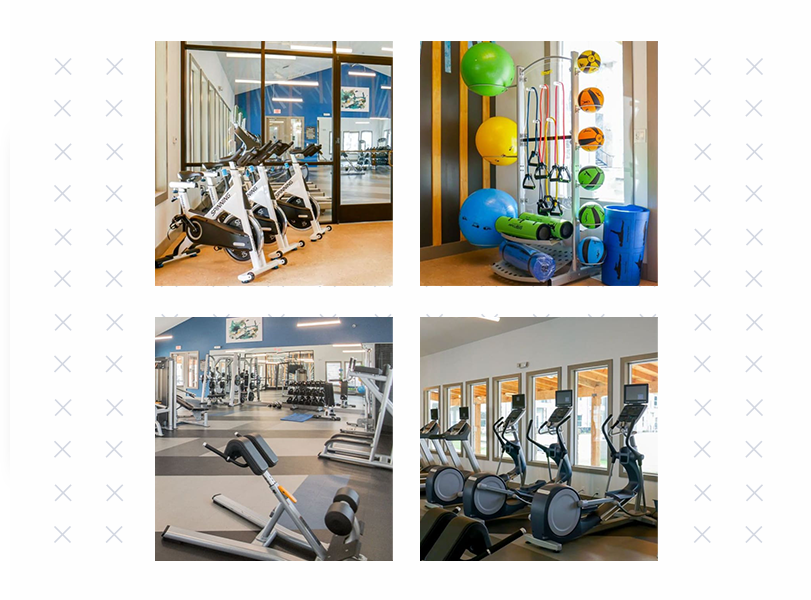
Multifamily professionals know that the real value in a property lies in offering amenities that appeal to potential renters and align with their evolving expectations and lifestyle needs. Surprisingly, only 15% of multifamily professionals track the usage of their apartment amenities, according to Multifamily Insiders. This gap represents a missed opportunity to tailor offerings that resonate with residents and maximize property value.
Today’s renters are increasingly looking for more than just a place to live — they want a lifestyle that suits their needs and preferences. For example, residents may be willing to commute a bit farther if it means having access to unique amenities like a rooftop lounge, a pet spa, or additional green space. Multifamily professionals have noted that residents are particularly “wowed” by more unconventional offerings such as blow-out hair bars, package lockers, beverage stations, and even crystal lagoons.
3. Location and Amenities as Key Investment Factors
Suburban and garden-style communities remain attractive investments, especially in areas with strong school districts and high barriers to entry. Properties that blend location advantages with desirable amenities continue outperforming competitors, driving long-term resident retention and sustained rent growth.
4. Multifamily Investment Volumes Set to Rebound
Transaction volumes are expected to increase as interest rates stabilize and capital markets become more favorable. Investors should watch for potential pricing corrections in high-supply markets, as well as opportunities to acquire well-located assets below replacement cost.
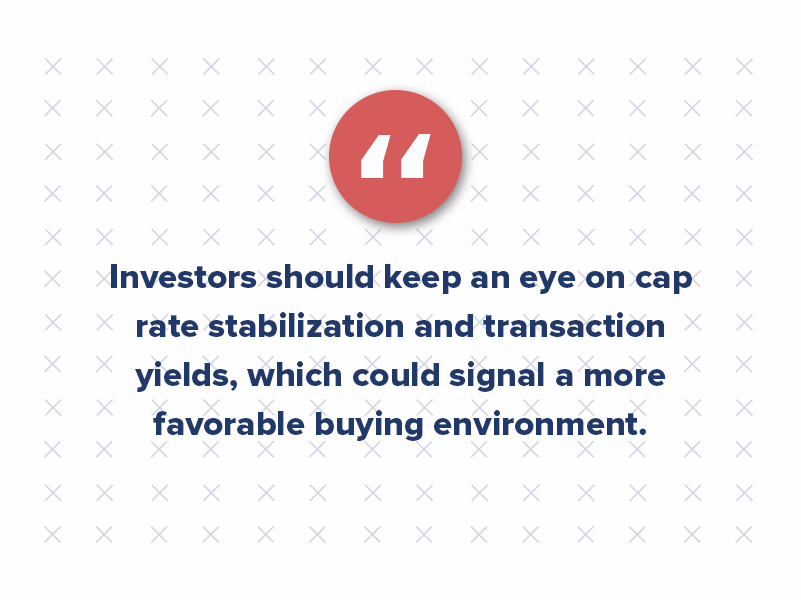
5. Fewer Investors, More Strategic Opportunities
With some traditional investors pulling back, the market is presenting unique opportunities for well-capitalized buyers. Those with access to liquidity and strong lender relationships will have the chance to acquire prime multifamily assets at competitive pricing in late 2025.
6. Oversupply Challenges in Certain Markets
Major markets that experienced a surge in new development over the past few years face oversupply concerns. Lease-up properties offer aggressive concessions, creating challenges for stabilized assets competing for renters. While long-term demand remains strong, the near-term leasing environment may require strategic pricing and marketing adjustments.
7. Aging Demographics Fueling Senior Housing Demand
As the population aged 80+ grows, senior housing is seeing increased investor interest. While new construction has slowed, demand is rising, leading to increased occupancy rates and potential consolidation within the sector.
8. AI and Tech-Driven Risk Mitigation in Insurance
With rising insurance costs, multifamily owners leverage AI-driven smart home technology to mitigate risks like water damage and fires. Properties implementing predictive maintenance solutions and IoT-enabled monitoring systems are seeing lower premiums and improved coverage terms.
9. Hyper-Targeted Marketing and Localized Outreach
Property managers are prioritizing hyper-localized marketing campaigns, leveraging partnerships with local businesses and influencers to boost engagement. Digital advertising platforms are also enabling more precise audience targeting, helping properties maximize their marketing spend.
For example, partnerships with local sports teams or cultural organizations can enhance a property’s visibility and community presence. This approach is particularly effective in markets where traditional marketing efforts may be less impactful.
Discover 10 more ways to market your business in the multifamily market through partnerships, events, sponsorships, and syndications in our blog.
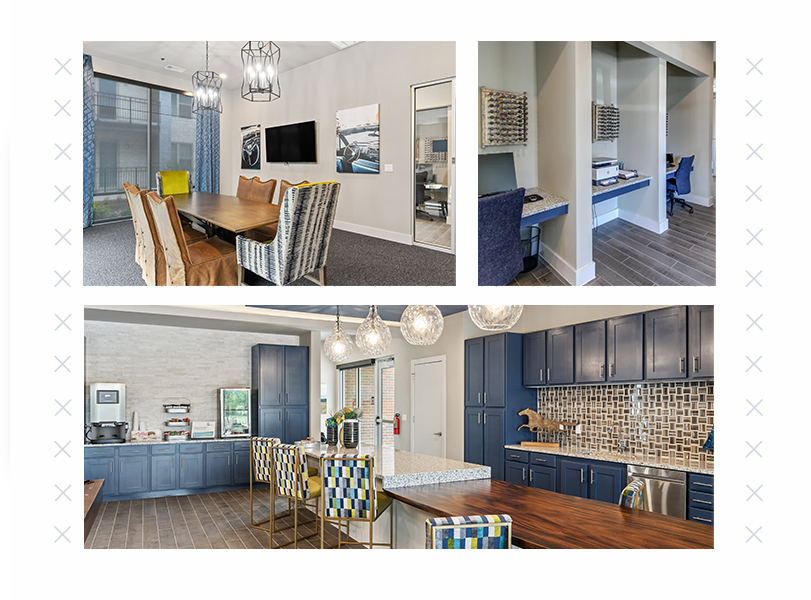
10. RFlexible Workspaces Driving Renovation Strategies
Coworking-friendly apartments are in high demand, with listings featuring work-friendly amenities receiving 16% more saves and 23% more shares daily. Developers are adapting common areas to include quiet workspaces, high-speed internet, and collaborative meeting spaces to cater to the growing remote-work trend.
These renovated areas often include open kitchens, lounge seating, and work-from-home accommodations designed to create a vibrant and flexible environment for residents. By focusing on these renovations, developers can enhance the appeal of their properties and meet the evolving needs of today’s renters.
Adapting to the Future: Strategies for Multifamily Success
While the multifamily market faces economic headwinds, strategic investments and adaptability will be key to success in 2025. Developers and investors who focus on high-demand locations, technology integration, and evolving renter needs will be best positioned to capitalize on emerging opportunities. Staying ahead of these multifamily trends will ensure a competitive edge in a rapidly evolving landscape.
At Criterion.B, we’re here to help you navigate these changes and maximize the opportunities. If you want to refine your marketing strategy or explore new avenues for growth, contact our team today.
Top Predictions & Multifamily Statistics to “Thrive in ’25”
The mantra “Thrive in ’25” is more than an aspiration — it’s a rallying cry for multifamily professionals navigating an evolving industry. While challenges like rising vacancies and changing renter demographics persist, the multifamily sector is also ripe with opportunities for those who adapt.
2025 signals a transformative period with significant renter expectations, investment patterns, and digital engagement shifts. Here are 11 updated multifamily statistics every executive should keep in mind for this pivotal year:
1. Vacancy Rates Reach 6.5% Amid Record Supply
Vacancy rates have climbed to 6.5%, reflecting the pressure from record-high new construction deliveries. As of January 2025, the national occupancy rate has dropped to 93.9%, its lowest since 2013. This underscores the urgent need for innovative leasing strategies as competition intensifies.
2. Rent Growth Stabilizes at 1.2%
With a 1.2% projected rent growth for 2025, affordability concerns remain at the forefront. This stabilization reflects a balance between maintaining occupancy and addressing renters’ financial constraints as job growth slows in many metro areas.
3. Digital Engagement on the Rise
Most renters now begin their apartment search online with many expecting virtual tours as a standard offering. About 98% of apartment searchers use online resources when looking for their next home and 20% use online sources only. Additionally, 68% of renters are willing to pay more for properties with strong online reputations. Positive reviews are crucial, as renters increasingly trust digital platforms to guide their decisions.
Here are a few more multifamily statistics to note:
- Most renters book tours the same day they discover a property, with over 60% requesting a tour within 24 hours and nearly 25% reaching out within just a few hours.
- Only 9% of renters remembered seeing property information on Instagram. 47% of U.S. adults use Instagram.
- Only 5% remembered seeing property information on TikTok. 33% of U.S. adults use TikTok.
- Only 2% remembered seeing property information on Snapchat. 27% of U.S. adults use Snapchat.
- 41% of renters across all age groups prefer using automated tools to book tours, with this preference reaching 59% for those aged 18-24.
- While nearly 50% of renters expected their search to take at least four months, 86% found a home in three months or less.
4. Sustainability Matters to 65% of Renters
Demand for sustainable housing continues to grow, with 65% of renters actively seeking eco-friendly apartments in 2025, according to Apartments.com. Features like energy-efficient appliances and on-site recycling programs are now non-negotiables for a large portion of the market.
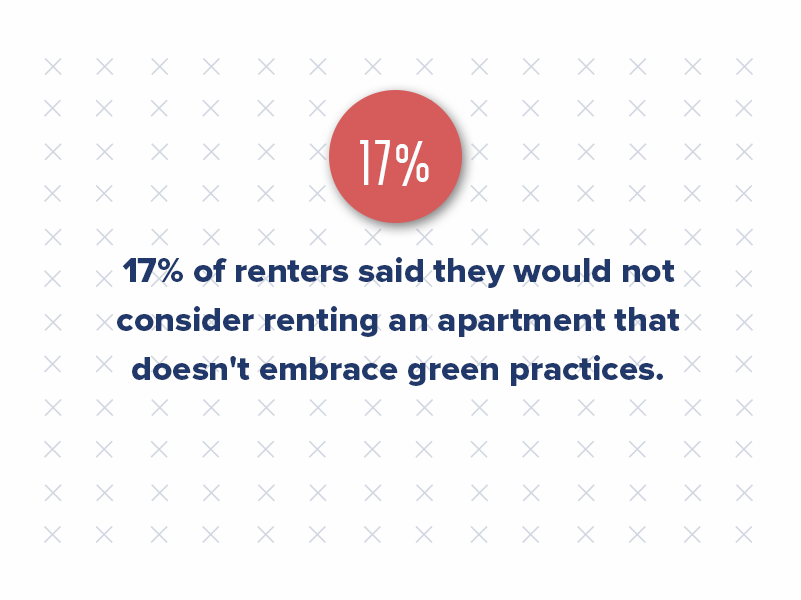
Among the eco-friendly features in high demand, on-site recycling programs and energy-efficient windows emerged as the most coveted by renters, pointing to specific areas where multifamily properties can invest to attract eco-conscious residents.
5. 51% of Renters Consider Smart Home Tech Essential
The demand for smart home technology among renters, especially those with incomes exceeding $100,000, transforms it from a luxury to a necessity. A striking 51% of these renters now consider smart home technology essential, while 48% view property technology (Proptech) as indispensable.
The willingness to invest in these amenities is notable, with over half of the respondents ready to pay an additional 1-10% for properties with advanced technology. Furthermore, nearly three in ten are open to paying at least 11% more, emphasizing the growing significance of proptech in the rental market.
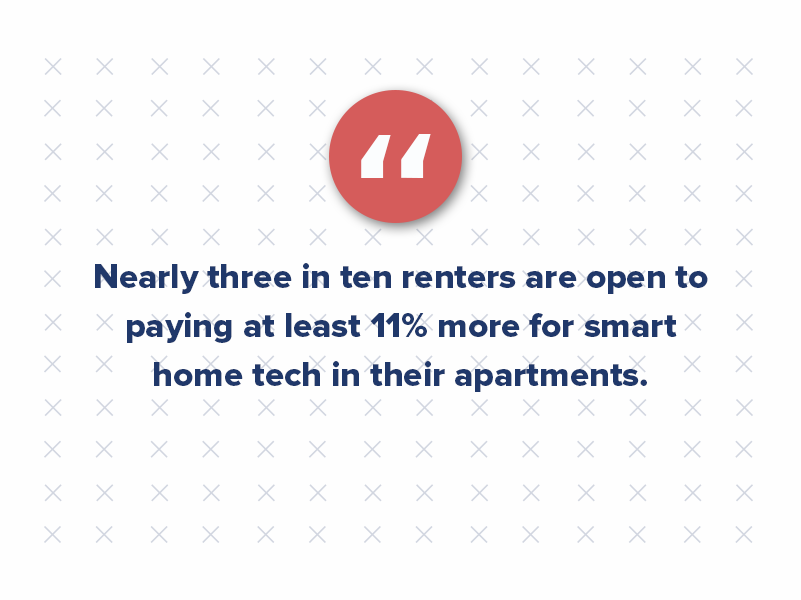
6. Pet Ownership Continues to Shape Renter Preferences
Pet ownership among renters has grown significantly in recent years. By 2023, 59% of renters reported having at least one pet, a notable rise from 46% in 2019. This trend remains strong, as highlighted by the Zillow Consumer Housing Trend Report, which underscores the critical role of pet-friendly policies in rental decisions.
A pet-friendly patch of turf, especially with convenient access to waste bag dispensers, can make a big impact. Rental units highlighting this amenity saw 76% more daily saves and 91% more daily shares, showcasing the strong appeal of thoughtful pet accommodations.
Here are key multifamily statistics from the report:
- The pet filter reigns supreme: Pet-friendly options are the most commonly used search filter on Zillow, with twice as many renters toggling this filter as any other amenity. Over half of Zillow’s rental listings last year were marked as pet-friendly.
- Pets outnumber children in rental households: An impressive 58% of renters report having a pet, compared to just 33% who have a child and 47% who own a plant.
- Restrictions can be deal-breakers: Nearly half of renters (44%) said they passed on properties that banned pets, and 32% avoided rentals with pet breed or size restrictions.
- Pet policies are essential for six in ten renters: For 60% of renters, allowing pets is a decisive factor when choosing a rental. This figure rises to 67% for single-family renters and 57% for multifamily renters.
- Pet policies influence renewals: Among renters who renewed their leases, 60% cited pet-friendly policies as a major reason for staying, alongside factors like affordability (72%) and quiet neighbors (69%).
As renters increasingly prioritize pet ownership, multifamily properties that embrace pet-friendly policies will have a competitive edge. This trend is particularly significant among Gen Z renters, who are becoming a larger market share and showing strong preferences for pet-friendly living. Understanding and catering to these preferences can position properties for greater tenant retention and appeal.
7. Majority of Renters Seek Home Office Space
As remote work shapes renter preferences, coworking spaces and work-friendly amenities are becoming must-haves in multifamily properties. Instead of traditional business centers, renters now prioritize listings featuring dedicated coworking spaces. According to the Zillow study, these listings see 16% more daily saves and 23% more shares, highlighting the growing demand for adaptable, work-focused environments. Offering features like private workstations, high-speed internet, and comfortable lounge areas can make your property stand out to remote workers and hybrid professionals.
8. Gen Z Renters Continue to Shape the Market
Generation Z isn’t just entering the rental market; they’re rapidly transforming it. Gen Z now represents 10% of the rental population, and their preferences — tech-forward amenities, flexible leases, and vibrant community spaces — are reshaping multifamily marketing. At the same time, homeownership for Gen Z remains under 1%, further solidifying their role in the rental market.
9. Multifamily Investment Volumes Begin Recovery
After a 60% drop in investment volumes in 2023, 2025 shows early signs of a rebound, supported by falling interest rates and renewed investor confidence. Multifamily remains a preferred asset class, with federal rate cuts expected to spur activity in Q3 and Q4.
10. 31% of Renters Spend Over 30% of Their Income on Rent
The affordability crisis remains critical, with 31% of renters allocating over 30% of their income to housing costs. Addressing this issue with affordable rent structures and value-added amenities will be key to maintaining tenant satisfaction.
According to iPropertyManagement, homeownership has declined, with 36% of American households now opting to rent rather than own. This shift is significant, reflecting broader economic and societal changes.
Complicating the picture, Flex reports that only 45% of renters feel financially positioned to purchase a property in their city, considering the average home prices. This multifamily statistic is particularly striking when compared to the median household income of homeowners in the U.S., which stands at $72,615. These figures highlight the widening gap between the cost of owning a home and the financial realities facing many renters today.
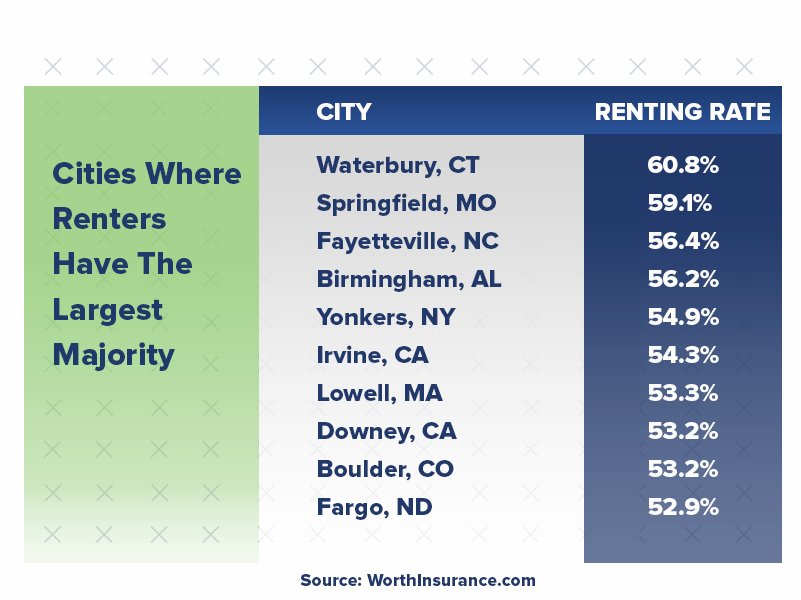
As we navigate these complex dynamics, the multifamily sector must grapple with the challenge of making housing both accessible and affordable, all while adapting to the evolving preferences and needs of a diverse renter population.
11. AI-Powered HVAC Systems Are Redefining Comfort and Efficiency
Integrating artificial intelligence into HVAC systems transforms how multifamily properties manage indoor climates. Traditional HVAC systems operate reactively, adjusting temperatures based on preset controls. On the other hand, AI takes a proactive and dynamic approach by analyzing real-time data, such as outdoor weather, occupancy patterns, and humidity levels, to optimize comfort and energy efficiency.
For instance, AI systems can determine that maintaining a slightly higher temperature with balanced humidity can provide the same comfort level as a lower temperature setting, thereby reducing energy consumption. This focus on occupant comfort, rather than rigid temperature points, enhances the living experience for residents while contributing to operational savings for property managers.
AI-enabled HVAC systems go beyond temperature control, offering cutting-edge capabilities like:
- Occupancy Awareness: AI learns usage patterns, ensuring energy is only spent on occupied spaces. For example, the system can detect increased activity in shared spaces like gyms and adjust airflow or cooling to maintain comfort.
- IoT Integration: These systems seamlessly connect with devices such as automated blinds and ceiling fans to optimize energy use.
- Predictive Maintenance: AI diagnoses potential issues before they cause system failures, recommending specific actions or parts, reducing downtime, and minimizing costs.
What Do Renters Really Want?
Navigating the multifamily market requires a deep understanding of renter preferences and expectations. A recent survey sheds light on the disconnect and alignment between renters and landlords, offering valuable multifamily statistics for executives aiming to refine their offerings.
Here are the key findings:
- 76% of renters believe landlords have a “pretty” or “very” good understanding of what they desire in a rental property.
- 86% of property managers are confident they understand renter preferences at least well.
- Renters were willing to pay more than property managers expected for three amenities: convenient payment options, guest parking, and flexible lease terms.
- Property managers overestimated renters’ willingness to pay extra for pet-friendliness and proximity to high-quality schools.
- A significant 48% of renters prioritize specific features over affordability.
- In contrast, only 18% of landlords believed that features were more important to renters than affordable rental rates.
These insights underscore the importance of multifamily executives and property managers aligning their offerings with renter preferences, mainly when misconceptions about value and priorities exist. By focusing on the amenities and terms that renters truly value, multifamily properties can better meet the needs of their target audience, ensuring satisfaction and fostering loyalty.
Understanding these multifamily statistics provides multifamily executives with a comprehensive view of the current market trends, renter preferences, and investment dynamics. With this knowledge, industry leaders can devise strategies to address today’s challenges and capitalize on emerging opportunities to ensure sustained growth and success this year.
Expert Tips to Avoid Property Management Nightmares
The life of a property manager is a juggling act. You’re responsible for everything from resident relations and maintenance to budgeting and legal compliance. It’s no wonder that mistakes can happen, especially for new property managers or those managing a growing portfolio.
The good news is that by identifying common pitfalls, you can take proactive steps to avoid them.
Here’s a look at some of the biggest mistakes property managers make, along with actionable tips to keep your properties running smoothly:
1. Failing to Properly Screen Residents
A bad resident can be a nightmare for any property manager. They can damage the property, disrupt other residents, and drain your time and resources.
The fix? Implement a thorough screening process that includes credit checks, rental history verification, employment verification, and reference checks. Don’t skip this crucial step — a bad resident can cost you far more in the long run than a thorough screening process ever will.

2. Not Having Clear Lease Agreements
A well-written lease agreement protects both you and your residents. It should clearly outline the rights and responsibilities of both parties, including rent amount, due dates, late fees, pet policies, maintenance procedures, and termination clauses.
The fix? Use a standardized lease agreement that has been reviewed by a lawyer. Keep it updated with any local or state regulations that may change.
3. Letting Maintenance Requests Pile Up
Prompt and thorough maintenance is a cornerstone of successful property management. Like addressing resident complaints quickly, addressing maintenance requests swiftly is essential to avoid a cascade of negative consequences.
Here’s why prioritizing maintenance is crucial:
- Protecting Your Investment: Regular maintenance plays a vital role in preserving the condition of your properties. Neglecting repairs can lead to further deterioration, decreased property value, and higher operating costs. Think leaky faucets that escalate to water damage or clogged gutters that lead to foundation issues. Addressing minor issues promptly saves you money in the long run.
- Resident Satisfaction & Safety: Living in a well-maintained property contributes significantly to resident satisfaction. Ignoring maintenance requests creates frustration and a sense of neglect. Prioritizing repairs ensures a safe and comfortable living environment for your residents.
- Reduced Liability: Letting maintenance issues linger can expose you to legal trouble. For instance, a slip and fall because of an unaddressed ice patch on the sidewalk could result in a lawsuit. By promptly addressing maintenance requests, you’re mitigating potential liability risks.
Here’s how to ensure your properties are well-maintained:
- Routine Inspections: Schedule regular inspections of your properties to identify potential problems before they become major issues. This could involve monthly walkthroughs or annual comprehensive inspections.
- Qualified Contractors: Develop relationships with qualified and reliable contractors who can handle various maintenance tasks. Verify references to confirm licensure and insurance. Oversee the quality and timeliness of their work to ensure efficient repairs.
- Budgeting for Maintenance: Don’t underestimate the importance of budgeting for maintenance and repairs. Factor in routine maintenance costs and a reserve fund for unexpected emergencies and major repairs. This ensures you have the resources readily available when needed.
- Communication Is Key: Like with resident complaints, keep residents informed throughout the maintenance process. Acknowledge their request promptly, explain the repair timeline, and provide updates if any delays occur. Open communication fosters trust and reduces frustration.
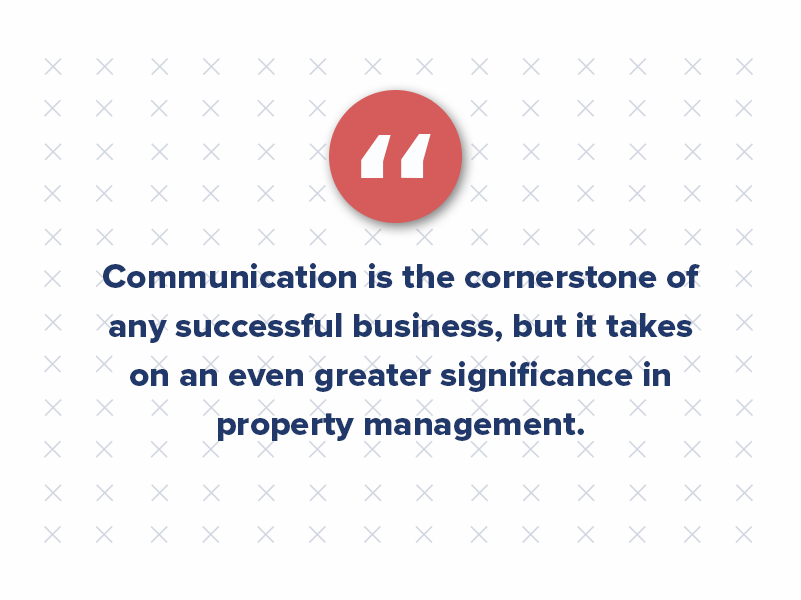
4. Poor Communication With Residents
Communication is the cornerstone of any successful business, but it takes on an even greater significance in property management. You’re constantly juggling interactions with a diverse group — your team members, property owners, residents, and vendors. When communication breaks down, it can lead to misunderstandings, conflicts, delays, errors, and ultimately, dissatisfied customers.
Here’s how to ensure smooth communication:
- Establish Clear Channels: Don’t leave your team and renters guessing how to reach you. Set up designated communication channels — email, phone calls, text messages, or online platforms like resident portals. Consistency is key — don’t make them chase you down across multiple platforms.
- Frequency & Transparency: Aim for frequent, transparent communication. Regular updates keep everyone informed and in the loop. Don’t be afraid to share both good and bad news promptly and honestly.
- Tailored Communication: A one-size-fits-all approach won’t work. Tailor your communication style to your audience. Use clear and concise language with residents, provide detailed reports to property owners, and foster open collaboration with your team.
- Feedback & Listening: Communication is a two-way street. Listen to your team and renters’ concerns, questions, and suggestions. Provide positive and constructive feedback to keep everyone motivated and on track. Respond promptly and professionally, demonstrating that their input is valued.
- Technology Advantage: Fortunately, technology is on your side. Utilizing property management software streamlines communication by centralizing information, automating tasks, and facilitating easy access for all parties involved. This reduces the risk of errors and keeps everyone on the same page, boosting overall efficiency.
- Building Relationships: Effective communication goes beyond simply sharing information. It’s about fostering trust and building strong relationships. Schedule regular team meetings to discuss projects, address concerns, and celebrate successes. Open communication fosters a collaborative environment where everyone feels comfortable contributing their best work.
5. Not Keeping Records and Documents
Failing to organize and store important documents properly can lead to a domino effect of problems, including missing records. Missing or disorganized records can make tracking important information (i.e., lease agreements, maintenance requests, and financial transactions) difficult. This can lead to confusion, errors, and wasted time.
Without clear documentation, disputes with residents over rent payments, security deposits, or repairs can become tangled. Without proper records, you may be unable to defend your position in a legal dispute, potentially resulting in hefty fines or even lawsuits.
Here’s how to ensure your records are organized, secure, and accessible:
- Secure Storage: Utilize a secure and accessible system for storing your records. Cloud-based storage solutions offer convenience and accessibility, while traditional filing cabinets can work for paper documents.
- Regular Review and Updates: Don’t let your records become an archive of forgotten paperwork. Schedule regular reviews to ensure all documents are accurate and up-to-date.
- Compliance With Regulations: Retention laws vary depending on your location. Familiarize yourself with the relevant regulations regarding record keeping and disposal. Understanding these requirements ensures you’re adhering to legal mandates.

Effective record-keeping is a fundamental skill in property management. Most real estate transactions involve a mountain of paperwork — lease agreements, maintenance records, financial statements, and more.
Maintaining electronic copies alongside physical documents is essential in today’s digital age. This allows you to access crucial information even when you’re away from the office, ensuring you can always stay on top of your business.
6. Not Taking Advantage of Technology
Many property management software solutions can streamline your workflow and save you time. These tools can help you with tasks like screening residents, collecting rent online, managing maintenance requests, and generating reports. The fix? Research property management software options and find one that fits your needs and budget. Many offer free trials, so you can test them before committing.
7. Not Marketing Your Properties Effectively
Vacancies cost money. There’s no sugarcoating it. A well-defined multifamily marketing strategy is essential to attract qualified residents and keep your properties occupied.

Don’t put all your eggs in one basket. Utilize a diverse range of multifamily marketing channels to reach your target audience. This could include:
- Online Listings: High-quality listings on popular rental platforms are a must-have. If possible, showcase your properties with professional photos, detailed descriptions, and virtual tours.
- Social Media Marketing: Use social media to connect with potential residents. Share engaging social media posts, run targeted ads, and create a community around your properties.
- Website Presence: A professional website is a valuable asset. It lets you showcase your properties, provide leasing information, and establish your brand identity.
- Offline Strategies: Don’t underestimate the power of traditional methods. Yard signs, local print ads, and partnerships with businesses in your area can still be effective ways to reach potential renters.
While a do-it-yourself approach is possible, managing a comprehensive marketing strategy can be time-consuming, especially as your portfolio grows. This is where partnering with a marketing agency can be a game-changer.
Think of a marketing agency as an extension of your multifamily property team. They can provide a wealth of expertise and resources to help you achieve your marketing goals and increase your bottom line.
Here are just a few of the ways a marketing agency can streamline your marketing efforts:
- Streamlined Marketing Collateral: Ordering eye-catching flyers, brochures, and other marketing materials can be a hassle. Criterion.B offers a one-stop shop for designing and ordering all your promotional needs to save time and ensure brand consistency.
- Actionable Analytics & Reporting: A good marketing agency will leverage analytics tools to track the performance of your marketing campaigns. This data can reveal valuable insights into what’s working and what’s not. They can help you set up and track key metrics like website traffic, lead generation, and conversion rates.
- Search Engine Optimization (SEO): Improving your website’s ranking in search results so potential residents can easily find your listings.
- Email Marketing: Creating targeted email campaigns to nurture leads and connect with potential renters.
- Blogging and Content Creation: Developing engaging content that showcases your properties and attracts qualified leads via a blog post.
- Social Media Management: Creating engaging content and managing interactions with potential residents across all social media channels.
- Branding and Design: Developing a strong brand identity for your property management company, including logo design and website creation.
- Website Development and Management: Building a user-friendly website that showcases your properties and provides a seamless leasing experience.
8. Not Staying Up-to-Date on Industry Trends
The property management industry constantly evolves, with new technologies and regulations emerging. Staying informed is important to ensure your business runs as efficiently and effectively as possible.
The fix? Attend industry conferences, webinars, and workshops. Read industry publications and blogs to stay up-to-date on the latest trends.
Want quick marketing tips and multifamily trends delivered straight to your inbox once a week? Sign up for our weekly email list to stay informed!

9. Ignoring Complaints & Not Focusing on Resident Retention
High resident turnover can be a major drain on your resources. It involves advertising costs of vacant units, showing apartments, screening new renters, and processing paperwork. It can also result in a loss of rental income during vacancy periods. But the hidden costs are even greater — negative reviews, a damaged reputation, and a revolving door of unhappy residents.

Here’s how to cultivate a thriving community that keeps renters happy:
- Treat Renters with Respect: Building positive relationships starts with respect, courtesy, and professionalism. Respond to their needs and concerns promptly and effectively.
- Responsive Complaint Resolution: A well-defined system for handling complaints is essential. This includes a clear process for receiving, recording, and resolving issues. Respond quickly to complaints to explain how you’ll address the problem. Keep residents updated throughout the process, and follow up after the repair.
- Value Feedback and Communication: Open and transparent communication is key. Encourage feedback. Regularly solicit their input through surveys, resident meetings, or suggestion boxes. Actively listen to their concerns and suggestions, demonstrating their input is valued.
- Offer Incentives for Renewals: Show your existing renters how much you appreciate them by offering incentives for lease renewals. This could include discounts on rent, free parking, or waived application fees.
- Create a Sense of Community: Help your residents feel like they belong! Organize fun events, create social media groups for them to connect, or offer amenities that encourage interaction. When residents feel like part of a community, not just renters in a building, they’re more likely to want to renew their leases.
10. Micromanaging Your Team & Not Delegating Tasks
Learning the art of delegation becomes increasingly important as your property management portfolio expands. While you may be tempted to hold onto the reins and meticulously manage every detail yourself, this approach is ultimately unsustainable and can hinder your long-term success.
Micromanaging your team can have several negative consequences. It can stifle their motivation, creativity, and sense of autonomy. Constantly hovering over their shoulders can make them feel like they’re not trusted to do their jobs effectively, decreasing morale and productivity.
The solution lies in empowering your team through effective delegation.
- Delegate Based on Strengths: Analyze your team members’ skills, experience, and interests. Assign tasks that align with their strengths and allow them to develop new skills.
- Trust and Autonomy: Once you’ve delegated a task, trust your team to complete it without your constant oversight. Micromanaging every step is a recipe for frustration and resentment.
- Support and Resources: Provide your team with the necessary resources for success, such as training materials, software tools, and clear guidelines.
- Coaching for Growth: Don’t hesitate to offer guidance and support as needed. Regular check-ins and constructive feedback can help your team members grow in their roles.

Often, managers who micromanage their teams worry their employees aren’t doing a good job. If you don’t communicate well with your team or can’t motivate them, they might not feel like doing their best work. Instead of hovering over them, invest in becoming a better leader. Learn how to communicate clearly and build a team environment where everyone feels trusted and responsible for their work.
Remember, you hired your team for a reason — you believe in their skills and potential. Start by delegating smaller projects that allow them to demonstrate their capabilities. As they gain confidence and experience, gradually increase their scope of responsibility. If they hit a roadblock, provide coaching and support to help them develop the skills they need to reach the next level.

How to Support Consistent Growth for Your Multifamily Business
The multifamily market has seen a paradigm shift with the rise of inbound marketing. A comprehensive perspective is vital as you construct your marketing funnel, from crafting insightful blog posts to launching targeted Facebook ads.
New marketers eager to build captivating campaigns and hone their content marketing efforts might sometimes overlook crucial elements like the leasing agent’s strategic role and the nuances of the target audience.
Without a dynamic strategy for enticing potential customers, even the most detailed funnel risks stagnation. Ensuring that every facet of your marketing efforts works harmoniously is essential for generating loyal customers.
Focusing on the Funnel
A successful marketing idea hinges on mastering the inbound marketing funnel. For those who are new to this approach, it’s common to launch numerous campaigns with a keen focus on the buyer’s journey at every stage.
However, the true secret lies in optimizing strategies for prospective customers. Emphasizing search engine optimization (SEO) ensures your business consistently appears atop search results, making it more visible to potential customers.
Campaigns certainly have their place, but the key to long-term success is concentrating efforts at the funnel’s top. This is where initial interest from potential customers is captured.
Without this interest, there’s no pool of leads to nurture or engage with. Excellent customer service and content tailored specifically for your target audience is essential. With this approach, you can guarantee a steady flow of visitors and create opportunities to convert them into long-term customers or clients.
Making Your Multifamily Marketing Funnel Scalable
The key to any business growth is scalability. But how do you translate a marketing funnel to meet scalability needs?
The first requirement is to look solely at the numbers. If you are struggling to bring in 1,500 web visitors per month and are only converting that traffic to leads at a rate of 3%, the outlook for company growth is not promising.
When faced with this kind of issue, it is essential to change your funnel, albeit one at a time. Again, your concern should be primarily on your traffic generation or how to increase that visitation from 1,500. If nothing else, an increase in site traffic to around 5,000 monthly with a steady lead rate of 3% can still significantly impact your top-of-funnel multifamily leads from 45 to 150 a month.
But how do you increase this traffic to such a rate? Again, your focus should be content. Experimenting with your content tilt, improving your content amount, and changing how you promote your content can contribute to higher traffic.
Maintain Consistent Conversion Rates
Achieving a scalable marketing funnel hinges on the stability of conversion rates, a crucial metric for multifamily marketing professionals. The effectiveness of your efforts, particularly in areas like landing pages, forms, and special offers, plays a significant role in driving these conversion rates.
For instance, if you’ve historically experienced a 5% conversion rate from visitors to leads and a subsequent 1% from leads to actual customers, it’s paramount that these figures remain steady or, even better, show improvement to ensure the potential for long-term growth.
Consistent conversion rates don’t just offer a static picture; they enable forward-thinking marketers to predict the number of potential customers or clients that may enter the lead generation pool within a given timeframe. Moreover, closely monitoring these rates allows you to gauge the number of leads likely to transition further down the sales funnel.
The integration of well-maintained buyer’s journey content, coupled with feedback from your sales team and tactics such as multifamily SEO, ensures that your content resonates with the target audience and that you are on track to meeting the overarching objectives of your marketing campaign.
Keeping Up With the Content
For businesses seeing inbound success, it is tempting to lapse in your efforts or change direction due to comfortable growth. However, this can be incredibly damaging to your business. Your content needs to be consistent.
Again, we return to the issue of scalability. Knowing that content is the basis of bringing in multifamily traffic, it’s important to maintain that generation to maintain results. But how do you do that without your content growing stale? It’s a matter of knowing your audience so that you can take a leading approach in content creation.
Ideally, as you grow, it should be simple for your business to put processes in place to become a content machine. Keeping up with your content ensures your business can continue to grow easily.
Leveraging Technology for Insightful Thought Leadership
Multifamily businesses can’t afford to lag. Integrating technology and data analytics into your marketing approach can offer significant advantages.
1. Harnessing CRM Systems
Customer Relationship Management (CRM) tools are no longer a luxury but a necessity. These platforms give you a holistic view of each prospective customer, tracing their journey from mere visitors to committed customers or clients. Analyzing this data lets you pinpoint where potential customers or clients might drop off, allowing for timely interventions and targeted strategies.
2. Data-Driven Decision Making
Relying on gut feelings is a strategy of the past. Today, successful multifamily marketers bank on actionable insights derived from data analytics. By studying patterns, behaviors, and preferences of potential customers, marketing strategies can be fine-tuned to match the exact needs and desires of the target audience. This ensures higher conversion rates and, ultimately, more signed leases.
3. Automated Marketing Campaigns
Automation in marketing can be a game-changer. Imagine tailoring specific email campaigns for different segments of your audience, triggered by particular actions they take. This ensures that the content is relevant to the recipient and reaches them opportunely, increasing the chances of conversion.
4. Continuous Learning and Adaptation
The digital landscape is ever-evolving. What works today might not be as effective tomorrow. Therefore, continuous learning and staying updated with the latest marketing trends, technological tools, and best practices are crucial. Regular training sessions, workshops, and webinars can help multifamily marketers stay ahead of the curve.
While content marketing fundamentals remain rooted in understanding and catering to the buyer’s journey, the tools and technologies available to us have greatly expanded. These tools can help you maintain traffic and ensure sustained growth and expansion in an increasingly competitive market.
Beyond Likes and Shares: 5 Facebook Strategies for Modern Student Housing
Generation Z has become synonymous with online interactivity. Having grown up during the rapid expansion of the internet and with smartphones always within reach, they are a generation that prioritizes digital communication over traditional methods. For Gen Z renters, expressing themselves through text or sharing weekend escapades on social media is the norm.
Struggling to connect with them? It’s a two-way street. Just as you might find their digital-first approach bewildering, they might be equally puzzled by older communication methods.
Dive Deep Into the Digital World of Gen Z Renters
If you’re in the realm of student housing development and wondering why social media should be your go-to communication tool, consider this: the window to engage with these students is relatively short. Missing out on the platforms they frequent means missing out on key interaction opportunities.
Let’s talk about Facebook to start. About 70% of American adults use Facebook. And you might be thinking, are any of those users even Gen Z renters? Recent studies show only about 7% of Gen Z users plan to quit Facebook in 2023. While this isn’t the “first choice” social media platform for this demographic, they still use it.
So, what’s the best way to tap into the heart of Gen Z’s digital life, especially on platforms like Facebook?

1. Promote On-Campus Events Digitally
If you’ve observed dwindling numbers at on-campus events, it might be time to rethink your promotional strategy. Traditional flyers might not just be environmentally unfriendly but might also not resonate with Gen Z renters.
Instead, create Facebook event pages to promote these events. Showcase visuals from previous iterations (if it’s an annual event) to blend tradition with contemporary outreach methods.
2. Quick Weather Updates
Imagine a scenario where unforeseen weather conditions, like heavy snowfall, disrupt regular schedules, and classes must be canceled. Instead of relying on email notifications that might go unread, why not use Facebook?
With Gen Z constantly scrolling through their newsfeeds, timely posts about weather alerts ensure immediate dissemination of crucial information.
3. Disseminate General Announcements
Got updates about the residential facilities, changes in semester timelines, or items in the lost and found? Facebook is your platform! Craft concise posts enriched with visuals (images or videos) to swiftly inform your student housing community.
4. Foster a Community With User-Generated Content
User-generated content is one of the most genuine ways to boost engagement and build a sense of community. Encourage your residents to share their unique experiences, be it a quiet study session in the lounge, a fun community event, or even a serene sunset view from their apartment window.
Launch monthly challenges or themes where students can share photos or stories about a particular topic or hashtag. Not only does this provide fresh, authentic content for your Facebook page, but it also allows residents to actively participate in creating the narrative of their community. Celebrate and showcase this content by sharing selected posts or creating monthly highlights. This validates your residents’ efforts and paints a genuine picture of life in your housing facility, which can be an invaluable tool for prospective students evaluating their housing options.
5. Utilize Facebook Groups for Direct Engagement
Did you know that 1.8 billion people interact in Facebook groups every month?
Beyond your primary Facebook page, consider setting up dedicated groups for different blocks, year groups, or special interest communities within your housing complex. Facebook Groups offer a more intimate setting for discussions, feedback, and announcements specific to group members.
For instance, a group dedicated to residents interested in fitness could have announcements about gym timings, fitness challenges, or even resident-led yoga sessions. Similarly, a group for a specific block or building can discuss maintenance issues, attend community meetings, or even organize block parties.
You can offer tailored content and create a more personalized resident experience by segmenting your audience. Additionally, these groups foster peer-to-peer interaction, helping residents connect over shared interests or concerns. It’s about broadcasting messages, facilitating conversations, and building a supportive community.
Social Media Isn’t Just a Tool
While the digital landscape and preferences of newer generations might seem complex, remember that platforms like Facebook were ironically first conceptualized for college students. Embracing such platforms for your multifamily marketing can bridge the communication gap, foster a vibrant community spirit, and attract new apartment leads. If done right, social media isn’t just a tool — it’s a transformative force.
How to Create an Effective Resident Feedback Program
Properties need more than just aesthetic appeal to compete in today’s competitive landscape. Successful multifamily marketing lies in fostering a positive resident experience. While renowned authors and industry leaders routinely share insights on success, the heart of a thriving multifamily property is deeply rooted in its resident service and the effective implementation of a resident feedback program.
“Feedback is the breakfast of champions.”
— Brian Halligan, CEO, HubSpot
If you’re unaware of the shortcomings in your property’s amenities or services, how can you enhance them to benefit your residents? Moreover, you cannot amplify your strengths if you’re unaware of what’s resonating positively with them.
According to HubSpot, there has been an evident decline in trust in businesses. A staggering 55% of customers have lesser trust in the companies they once patronized, and an even higher 65% cast doubts on official press releases and advertising. Yet, the story changes when it comes to apartment reviews by peers. For multifamily marketing, resident reviews are gold.
Capitalizing on Resident Feedback in Multifamily Marketing
Referrals dominate as the primary source for new leads. Did you realize that retaining a happy resident in your multifamily property costs 5 to 25 times less than roping in a new one? Loyal residents can propel your property to success faster than any marketing strategy or sales pitch. And the journey begins with extracting genuine feedback.
Cambria Davies, Product Manager at HubSpot, aptly says, “To truly delight, understanding the resident expectations and gauging the current resident experience is pivotal.” Yet, many in the realm of property management marketing often overlook the real sentiment of their residents, primarily due to the lack of a structured feedback mechanism.
Simply sending out a generic satisfaction survey won’t cut it. If you aim to get actionable insights, then crafting a bespoke framework tailored to the multifamily sector is the way forward.
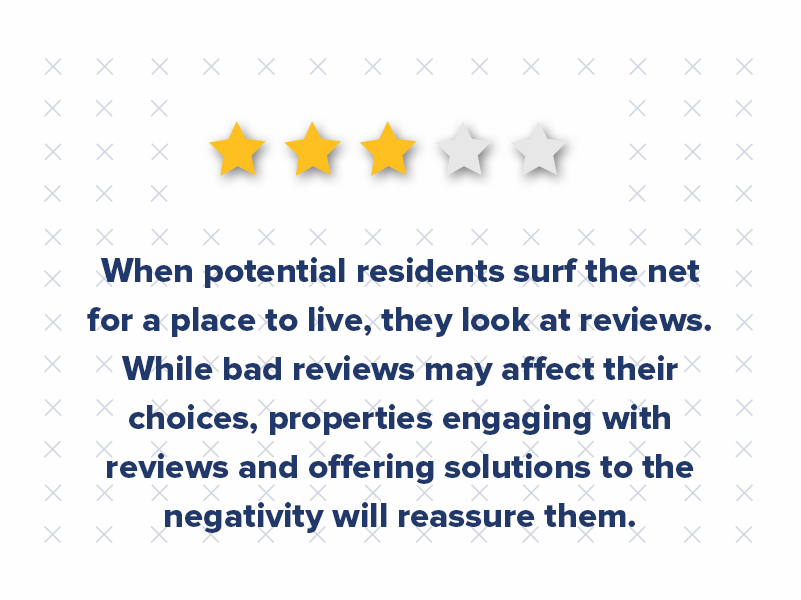
Building Robust Listening Channels
Avoid a one-size-fits-all approach when interpreting feedback. Every resident’s journey is unique, and you must respect that individuality. Instead of harping on generic issues like wait times or answering service delays, dig deeper. Listening posts provide a comprehensive method to assess resident experiences both individually and collectively, highlighting areas of improvement and success.
For effective multifamily marketing, align your survey methods with your overarching goals. Harness diverse feedback channels, including:
- Social Media
- Online Apartment Review Sites
- Engaging with Front-Line Staff
- Collating Resident Testimonials
- Distributing Tailored Satisfaction Surveys
- Direct Resident Communications
Deciphering Apartment Reviews
With a plethora of feedback, the challenge is to dissect and understand this data. Never let resident grievances go unnoticed. It’s pivotal to discern recurring themes or concerns. Categorizing feedback can spotlight areas demanding immediate attention, be it issues with amenities, maintenance response times, or the overall resident experience in your multifamily property.
For instance, if numerous residents appreciate the community but highlight persistent problems with parking, you’ve got a clear feedback theme: “parking,” with the specific issue being “availability” or “accessibility.”
Elevating the Resident Experience
Upon identifying the focal points, the next step is action. Begin by ranking the areas of improvement. Let’s say, if “security” surfaces as a prime concern in multiple apartment reviews, prioritize it over a lesser recurring feedback about gym equipment. Draft a pragmatic timeline and strategize solutions based on urgency.
Incorporate a proactive action plan, monitor its progress, and ensure your team stays aligned with the end goal. Maybe consider establishing a dedicated committee for consistent evaluations and reforms. This emphasizes the significance of enriching the resident experience and addresses potential roadblocks.
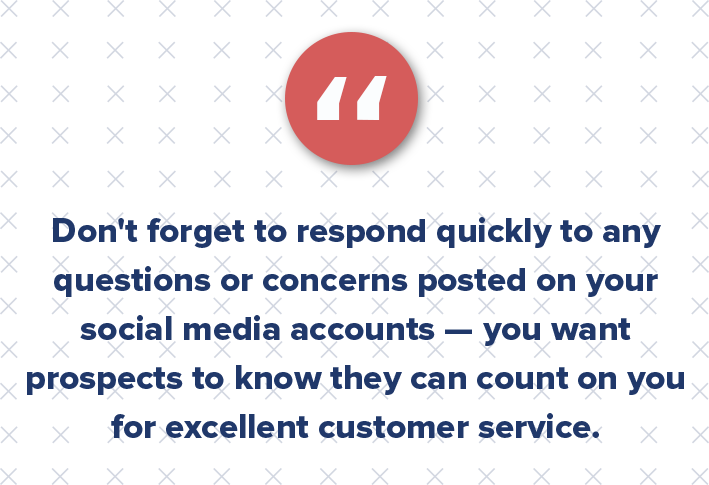
Conclusively, foster a genuine relationship with your residents. Directly engage with those who voiced concerns, assuring them that their feedback catalyzes positive change.
In the vast ocean of property management marketing, the properties that genuinely listen and adapt are the ones that truly stand out. Your resident’s voice is more than feedback; it’s the compass guiding your multifamily property toward excellence.
Maximizing Occupancy & Revenue: Strategic Insights for Multifamily Property Success
High occupancy rates are the golden ticket to success in multifamily real estate. But how do you attract and retain tenants consistently?
Today, we’re diving into some tactical tips to boost occupancy and increase your net operating income (NOI). Through the lens of property management marketing and multifamily branding, let’s unlock the potential of your property.

1. Revamp Your Online Presence
Modern tenants scout online before they visit in person. And there is nothing worse than an unresponsive, slow-loading multifamily website. A modern web design can be the difference between one lead and dozens. Ensure your website is mobile-responsive, user-friendly, and provides comprehensive information, all while encapsulating your multifamily branding essence.
Our multifamily branding agency will deliver a high-quality, responsive website and handle your apartment marketing so you can focus on what matters most — nurturing your leads.

2. Dive Into Social Media
Social media is indispensable in property management marketing. Platforms like Instagram and Facebook can showcase your property’s amenities, community events, and testimonials.
We treat your social media as an extension of your website — by embracing your customers and serving them relevant content. Our team of social media experts will help adhere to your brand voice to concept, publish, and manage daily social media content — including Stories, Reels, and lead-generating ads.
3. Hire a Multifamily Branding Agency
Are there inconsistencies in your multifamily branding? Are you ranking low in search results — or even not at all? Are you losing leads to your competitors? Has your multifamily marketing plan fallen by the wayside? Don’t let sporadic multifamily marketing and branding stunt your NOI.
An expert multifamily branding agency can help refine your brand, ensuring it aligns with your target audience and stands out from competitors. An agency can also offer invaluable insights and solutions to uplift your brand. Our seasoned perspective ensures your brand resonates with your target audience, distinguishing you from competitors. Moreover, with our comprehensive market knowledge and analytical approach, we can identify and rectify hidden challenges or overlooked gaps hindering your brand’s full potential and stunting your NOI.
4. Host Community Events
Community BBQs, game nights, or workshops can provide a sneak peek into the vibrant life prospective tenants can expect, driving occupancy. We recommend hosting small, more affordable events every month (at least) and larger events every quarter. You should also aim for one significant event open to the public each year, such as a large Battle of the Bands, a Christmas celebration, or a charity event with raffle prizes. These large events will draw in the broader community and spread the word about your property.
5. Offer Referral Incentives
Encouraging current residents to refer friends or family is a strategic move in resident acquisition. Many trust recommendations from those they know, making this a reliable method to attract potential renters. Offering your current residents a discount on their next month’s rent or a bonus, such as a gift card to a popular local restaurant, can incentivize them to promote your property actively.
6. Professional Property Photos
High-quality photos can make a vast difference in online listings. Consider hiring a professional for interiors and exteriors to put your best foot forward. A multifamily branding agency can also help you coordinate a professional photographer, so there is no sweat off your back!
7. Revise Your Marketing Materials
Update brochures, banners, and flyers. Ensure all marketing for property management showcases the latest amenities, resident testimonials, and any recent renovations. If you recently rebranded your online presence, you need this to reflect in your marketing materials.
A multifamily branding agency can help you pinpoint all the collateral pieces that need to be updated and upscale those branding elements to match the look and feel of your new brand experience. From rack cards and brochures to banners and event flyers, we can help you generate apartment leads with premium collateral.

8. Enhance Security Measures
Safety is a top priority for many renters. Implement security cameras, keyless entries, or 24/7 security personnel to boost your property’s appeal. Once these are all updated, promote them with pop-ups on your website, add them to social media, and send an e-blast newsletter to current and prospective residents on your email list. This can show current residents you are bettering the property for their benefit and show prospective renters that you prioritize a safe community.
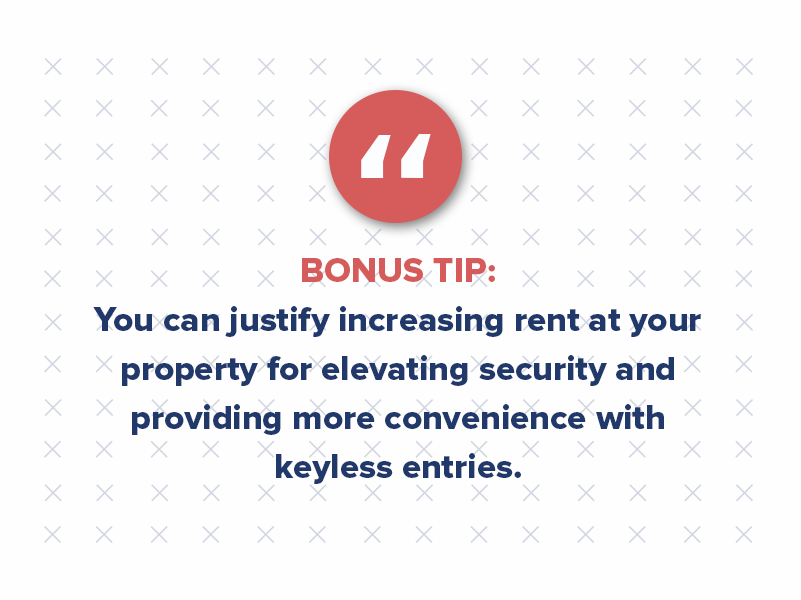
9. Offer Flexible Lease Terms
While not ideal for all properties, consider short-term leases or rent-by-room options. Flexibility can attract a wider range of potential residents. The short-term rental industry has seen an unprecedented surge in growth in recent years. In fact, the short-term rental market is expected to reach a valuation of $8,907.1 million by 2026. If your property has the means and logistics to tap into this market, you could open the door to some lucrative NOI.
10. Pet-Friendly Policies
Did you know that 72% of renters have pets, yet problems finding and keeping rental housing is a leading reason dogs and cats wind up in shelters?
Despite pets being prevalent in two-thirds of American households and integral to communities, many renters face challenges securing pet-accommodating residences. Shockingly, this housing dilemma leads to over half a million pets being surrendered to shelters annually, with many failing to find new homes. Even though the rental housing sector claims about 78% of apartment complexes are pet-friendly, the reality often contrasts starkly. Many properties impose weight restrictions, such as no dogs over 25 lbs. or having breed limitations. Hence, “pet-friendly” doesn’t truly represent most of America’s pets.
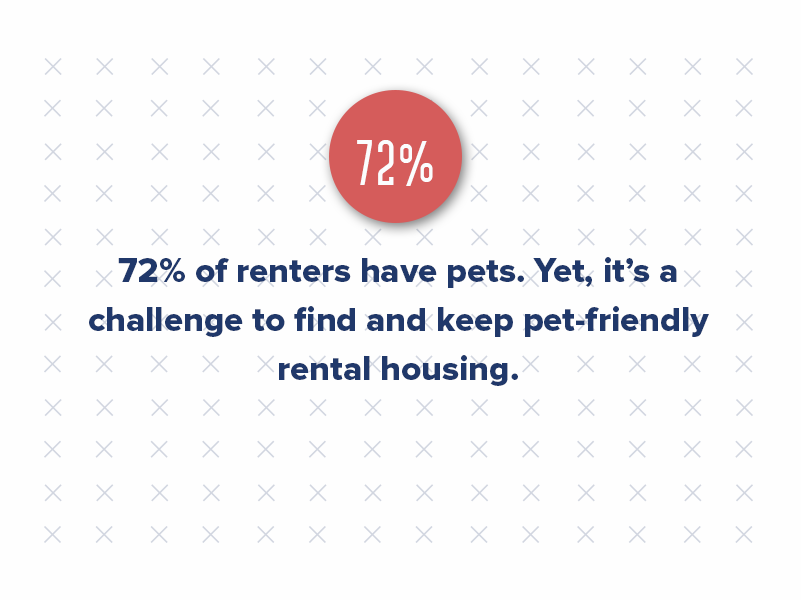
With more people adopting pets, offering a true pet-friendly policy (with appropriate rules) can be a significant attraction. Massive bonus points for the properties that also offer up pet-friendly amenities like dog washing stations, pet parlors, dog parks, and more. (p.s. This is also another way you can justify a rent increase!)
11. Implement Tech Upgrades
In today’s digital age, properties need to adapt to the ever-evolving technological demands of residents. Smart home features, such as voice-activated lighting, automated thermostats, and advanced security systems, offer convenience and modern living standards that appeal to a wide audience. High-speed internet has transitioned from a luxury to a necessity, especially for remote workers, avid gamers, or streaming enthusiasts.
Additionally, app-based service requests provide residents with a seamless way to communicate their needs directly to property management without the hassle of calls or in-person visits. As most people, regardless of age, have become adept with technology, integrating these features can significantly enhance the living experience and make a property more attractive to potential renters.

12. Maintain Immaculate Common Areas
First impressions matter. A visitor’s initial encounter with a property often sets the tone for their entire experience. Lobbies, hallways, and other shared spaces are the first touchpoints for prospective residents. Regularly cleaning and updating these areas is crucial for aesthetics and communicating the property’s commitment to maintaining a high-quality living environment. A clean and modern space exudes professionalism and care, making it a no-brainer for properties aiming to attract and retain residents who value such attention to detail.
13. Engage in Local Collaborations
Partnerships with local businesses can be a game-changer for multifamily properties looking to enhance the resident experience. Here are some ideas to get you started:
- Collaborate with the neighborhood café to offer exclusive morning coffee discounts for residents.
- Strike a deal with a nearby gym, providing discounted memberships or trial sessions.
- Local spas or wellness centers could provide tailored packages or special rates for residents.
- Coordinate with nearby bookstores, theatres, or artisanal shops to host monthly events or offer promotional deals to your residents.
By intertwining with the local business ecosystem, properties boost the appeal of community living and foster a deeper sense of belonging and convenience for their residents.
14. Actively Gather and Showcase Testimonials
Testimonials play a pivotal role in property management marketing. To encourage satisfied residents to share their experiences on platforms like Google, Yelp, or even Facebook, properties can implement a few thoughtful measures.
- Create a straightforward process for leaving reviews, perhaps by sending periodic reminders with direct links to the review platform.
- Consider hosting community events or appreciation days, and during these events, set up kiosks or dedicated spaces where residents can quickly drop a review.
- To motivate residents to share their feedback, offer small incentives, such as raffle entries or discounts on community amenities.
- To foster a culture of appreciation and engagement, regularly spotlight and thank residents for their positive reviews in community newsletters or social media.
Properties build trust with potential tenants and reinforce their commitment to current residents by actively seeking out and celebrating testimonials.
15. Offer Move-in Specials
Properties need to think creatively to catch the attention of potential tenants. Limited-time offers can be a game-changer in this regard. By providing reduced deposits, properties can appeal to those who might be budget-conscious or hesitant about the initial financial commitment. Offering a free month’s rent generates buzz and can provide the gentle nudge a prospective renter needs to choose your property over another.
Additionally, bundled utilities simplify the living experience, removing the hassle of multiple bills and presenting a more streamlined approach to monthly expenses. Combined, these incentives showcase the property’s commitment to providing value and position it as an accommodating and tenant-centric choice in a sea of options.
16. Efficient Response Systems
Prompt and clear communication is a cornerstone of building trust with potential renters. In an era where instant messaging and rapid customer service have set expectations for quick responses, any delay in addressing queries can reflect how the property operates.
When potential renters reach out with questions or concerns, they are not just seeking answers; they are gauging the responsiveness and reliability of the property management team. Addressing their queries promptly provides clarity and showcases a property’s commitment to tenant satisfaction.
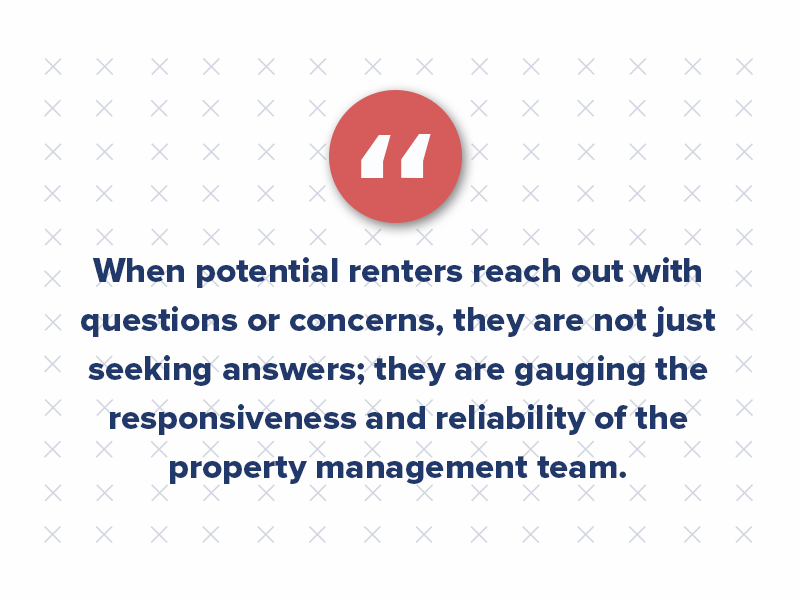
Efficient communication can often be the determining factor in a renter’s decision-making process. It bridges the gap between initial interest and final commitment, ensuring potential tenants feel valued and understood, ultimately making it more likely for them to choose your property over others.
17. Regular Market Analysis
Property managers and owners must be attuned to the pulse of the local rental market. With fluctuations in demand, economic shifts, and seasonal variations, rental prices can be highly dynamic. Staying updated on local market trends can help you gain insights into what competitors are charging, what amenities are in demand, and what potential renters prioritize in their housing search.
Proactively adjusting pricing in response to these multifamily trends doesn’t just ensure you remain competitive; it also demonstrates to potential residents that the property is in touch with the community’s needs and is adaptable. In a market where every edge counts, this level of responsiveness can be the difference between a fully occupied property and vacant units.
18. Enhance Green Spaces
An oasis of greenery in the form of well-maintained gardens, terraces, or even strategically placed indoor plants can significantly elevate the aesthetic and ambiance of a multifamily property. Beyond just their visual appeal, these green spaces and elements contribute to a sense of tranquility and well-being, offering residents a respite from the hustle and bustle of urban life.
The presence of plants can also improve air quality, acting as natural air purifiers. By investing in landscaping and indoor plants, properties not only enhance their visual appeal but also create a healthier and more rejuvenating environment. Such thoughtful touches signal a property’s commitment to providing residents with a holistic living experience, making it more enticing for potential renters seeking more than just four walls and a roof.
19. Invest in Upscale Amenities
Multifamily properties that offer more than just living spaces are capturing the attention of discerning renters. Common areas such as state-of-the-art gyms with the latest fitness technology, co-working spaces catering to the growing number of remote professionals, or entertainment zones with gaming areas and mini-theaters can truly set your property apart. These unique amenities serve as value-added propositions, providing residents with convenience, luxury, and diverse lifestyle options right at their doorstep.
These premium features offer a richer living experience, which warrants a justified increase in rent. When residents perceive tangible value in these amenities, they’re more likely to understand and accept a slightly higher rental cost. Ultimately, by elevating the standard of living through these specialized common areas, properties can significantly enhance their NOI while fostering a greater resident experience.
20. Continuous Staff Training
Investing in thorough staff training, especially in customer service excellence, is not just a box to tick; it’s a strategic move for the longevity and success of your multifamily property. Cutting corners in staff training can lead to missed opportunities, miscommunications, and unsatisfactory resident experiences, which can negatively impact your property’s reputation and occupancy rates.

When residents see familiar faces in the management team and service personnel, it fosters a sense of community and trust. Familiarity can often translate to increased comfort and security, which is essential in a resident’s decision to renew their lease.
On the flip side, frequent staff turnover can incur additional costs in hiring and training, and it may disrupt the seamless operation and rapport built with residents. In essence, by prioritizing staff training and retention, properties ensure smooth operations and a positive environment and enhance their bottom line by minimizing unnecessary expenses and optimizing renter satisfaction.
Boosting Demand with Comprehensive Multifamily Branding
Increasing occupancy and NOI is a blend of strategic multifamily branding, robust property management marketing, and understanding tenant needs. With these tips and the expertise of a multifamily branding agency, property managers can navigate the challenges of the rental market, ensuring their properties remain in high demand. Remember, in real estate, multifamily branding isn’t just a name — it’s an experience.

Why Senior Living Must Think Differently About Multifamily Leads
Senior living might not jump to the front of the brain when considering industries that benefit from inbound multifamily marketing. The boomer generation has joined the digital age with heels in the dirt, loudly proclaiming a preference for simpler times.
That’s not to say that boomers are digitally inept. However, their preferences lean to tradition, and senior living groups have taken note.
While 87% of American adults use the internet, the number drops to 57% for those aged 65 and older. This may seem like a clear-cut case for senior living marketers, but when you look at the next demographic group (50- to 64-year-olds), the number jumps to 88%.
Suddenly, the issue becomes clear. Not only will the market shift in the next few years to more tech-savvy residents, but the generation of adults seeking solutions for their aging parents are likely looking for senior living groups where they can’t or won’t be found.
The Newfound Power of Consumer Choice
As the post-retirement lifestyle changes, so do people’s purchasing decisions. The internet has shifted the buyer’s journey to one where consumers can research their needs without contacting sales.
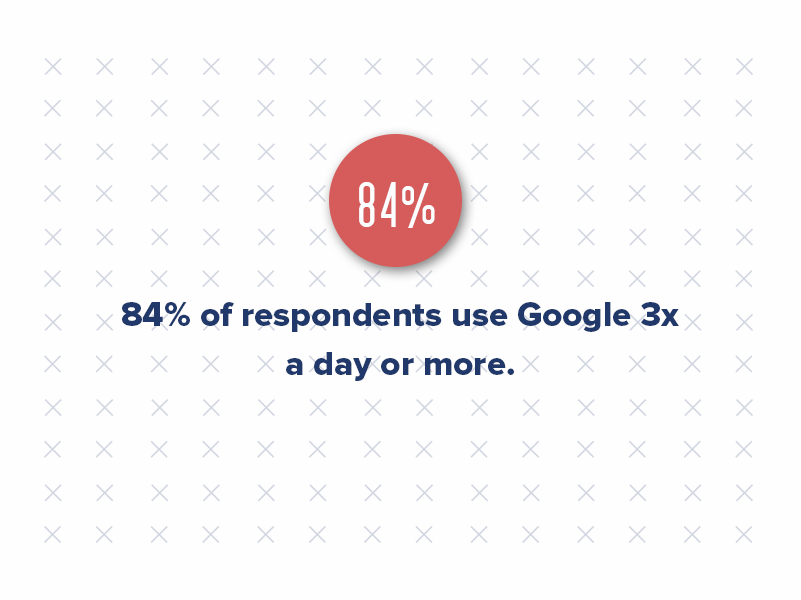
A majority of consumer research occurs on Google before turning to other resources, and 84% of respondents use Google three times a day or more. This is a huge detriment to groups that don’t have a digital presence and instead rely on mailers, word-of-mouth, and brochures. A senior living group that can’t be found through this methodology is missing out on consumer education opportunities.
Furthermore, digital content has a longer lifespan than physical materials due to the duration of information on the internet. This means the digital content bringing in leads returns a lower lead cost than traditional methodologies.
Targeting the Decision-Maker
When considering buyer personas for seniors, most people think of the active senior. Active seniors can make their own decisions and support themselves in post-retirement.
Many don’t consider the growing population of seniors who require assistance and rely on loved ones to make their decisions. The U.S. Department of Health and Human Services estimates that by 2050, the population of individuals using these types of long-term care services will double to 27 million. This is a significant shift that will transform the market completely. And for the children of this growing group of adults, research is key to finding high-quality care.

Given the high turnover that exists because the cost and care quality do not meet the expectations of adult children, representing the ability to meet these needs in your online content is vital to success. Educating multifamily leads on these options can build authority with the industry shift from institutionalized care to more community-based services.
The Benefits of Inbound Marketing for Senior Living
- Education and Awareness: Establishing a digital presence allows senior living communities to educate potential residents and their families about the benefits of senior living, the different care options available, and the overall lifestyle offered. Through informative blog posts, videos, and social media content, senior living groups can position themselves as authorities in the field and build trust with their target audience.
- Building Trust and Credibility: By consistently providing valuable and relevant content, senior living communities can build trust and credibility among potential residents. This trust is crucial in the decision-making process, as families want to ensure the well-being and happiness of their loved ones.
- Lead Nurturing: Inbound multifamily marketing enables senior living communities to nurture apartment leads by providing personalized and targeted content based on potential residents’ specific needs and interests. Through email campaigns, gated content, and personalized messaging, senior living groups can guide prospects through the buyer’s journey and ultimately convert them into residents.
- Increased Reach and Engagement: Digital platforms offer a vast reach and the ability to engage with a wide audience. Senior living communities can leverage social media platforms, paid advertising, and search engine optimization to increase visibility, attract qualified multifamily leads, and foster meaningful interactions with potential residents and their families.
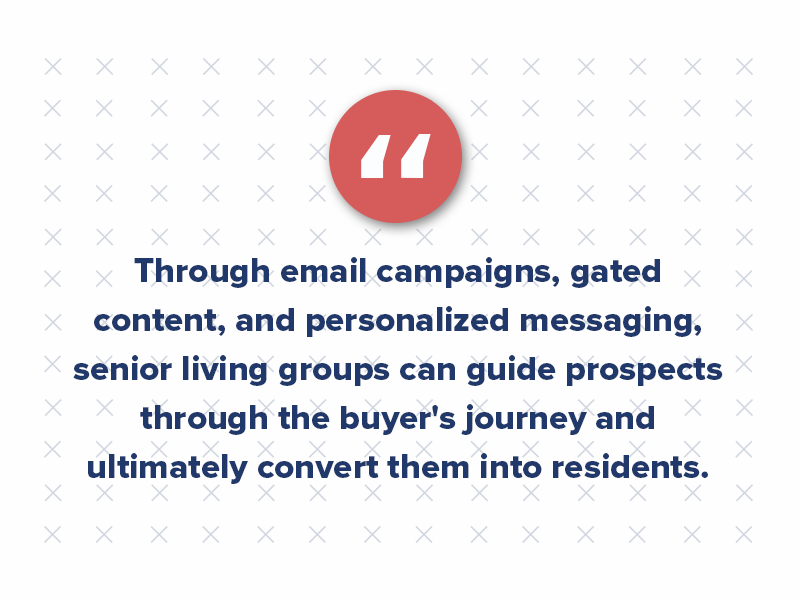
Why You Need Digital Apartment Leads for the Digital Age
These trends indicate a bigger change across the economic landscape — that both business and demographic trends are shifting to meet a world where technology is no longer an afterthought. This market shift means a necessary shift in strategy as well.
Older Americans shun traditional homes in favor of new alternatives, so senior living groups must be present online. By targeting online content to the appropriate groups, senior living communities can become a strong resource for active or older seniors. Without adopting this new direction toward lead generation, senior living may very well be shifted out of the market.
New Urbanism: Bringing New Life to Urban Living
Trends come and go, but sometimes they turn into a lifestyle. Improved urban living and environmental efforts are rising, but will they last?
As an apartment marketing agency, Criterion.B’s expertise in multifamily marketing and real estate gives us great insight into what’s coming and phasing out.
The New Urbanism movement is a trend that is rapidly gaining popularity. This urban planning philosophy seeks to create walkable, mixed-use communities that are sustainable, efficient, and livable.
The trend inspires remarkable change in urban planning, sustainability, and multifamily development, providing an alternative to the traditional suburban living model. And it just might be here to stay.
What are this new-urban renewal plan’s challenges, benefits, and concerns?
The Background of New Urbanism
The movement has garnered new life since it gained momentum roughly 25 years ago. Before the late ’80s and early ’90s, the urban environment was typically avoided and crime-ridden; the suburbs remained the hub for retail, restaurants, and recreation.
However, New Urbanism changed that by replacing negative city stigmas with fresh architecture, cleaner streets, and green initiatives. As a result, a renewed concept of urban living emerged. New Urbanism brought new life to the city, and Americans flocked to experience this lifestyle.
Benefits of New Urbanism in Multifamily Development
The New Urbanism trend attracts much interest from developers, investors, and homebuyers alike. One of the key benefits of this trend is that it creates a more walkable and livable environment. Residents can walk to work, shopping, dining, and entertainment destinations, reducing their reliance on cars and improving their quality of life.
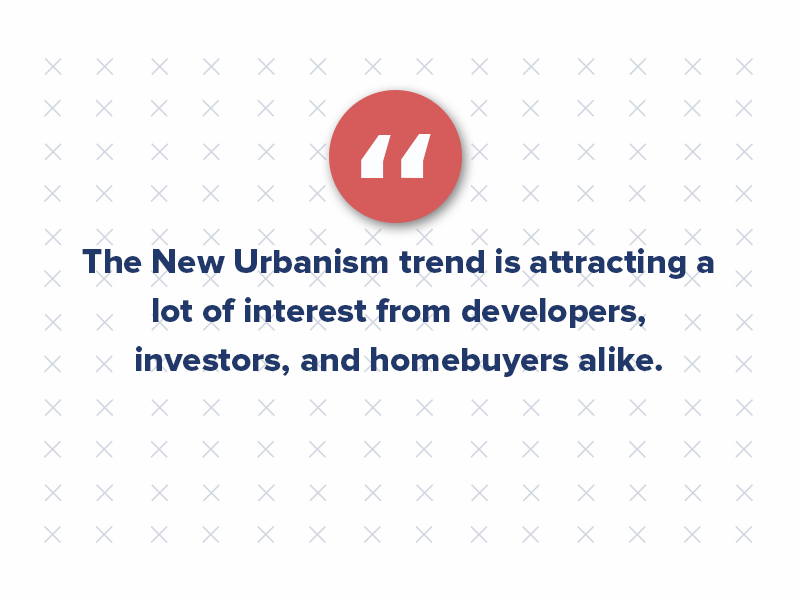
In addition, New Urbanism encourages public transportation, making it easier for residents to get around without a car. This helps reduce traffic congestion and air pollution while also promoting sustainability.
Another benefit of New Urbanism is that it provides a mix of residential, commercial, and retail spaces within the same multifamily development. This creates a sense of community, making it easier for residents to interact with their neighbors and the surrounding environment.
Nowadays, it’s unsurprising for young professionals and active individuals to live in the city’s heart. Millennials, especially, are driving this movement (whether they know it or not). They clearly desire prime locations, luxurious amenities, and walkable neighborhoods. As a result, these requirements force urban multifamily properties to keep up and stand out. The millennial lifestyle exemplifies New Urbanism and stimulates the evolving urban revival.
A great example of New Urbanism in action is Klyde Warren Park. Take a busy, bustling city, and drop a giant patch of grass on top of an Interstate overpass. That’s the exact action Dallas City Planning took to revitalize the city streets. Stop by, and you’ll find a line of food trucks, yoga classes in the park, picnic blankets, a playground, and a band playing at sundown. Cities flourish when safety, community, and accessibility are at the forefront of planning.
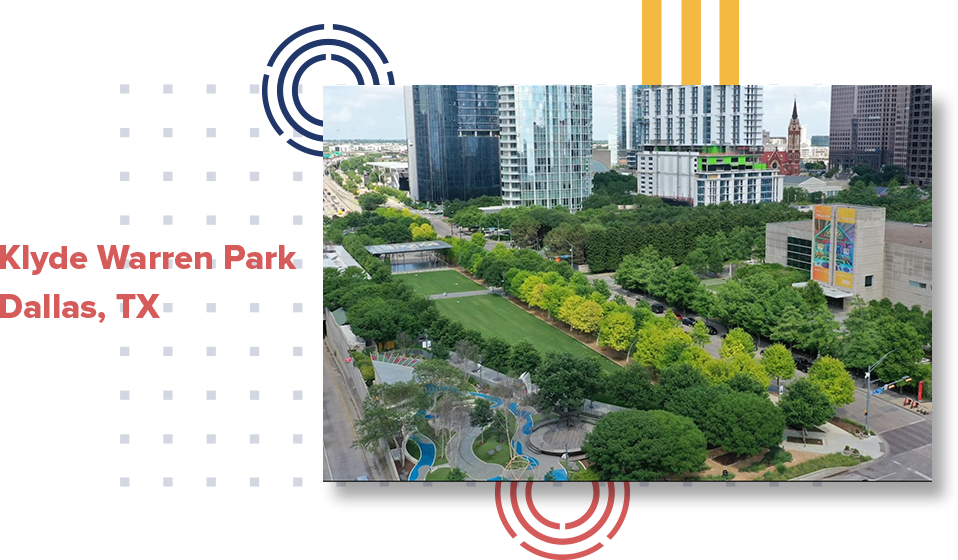
Challenges in New Urbanism Multifamily Development
However, there are also challenges and concerns associated with New Urbanism. One of the biggest concerns is the cost. Developing New Urbanism communities can be more expensive than traditional suburban multifamily developments due to the need for infrastructure such as sidewalks, bike lanes, and public transportation.
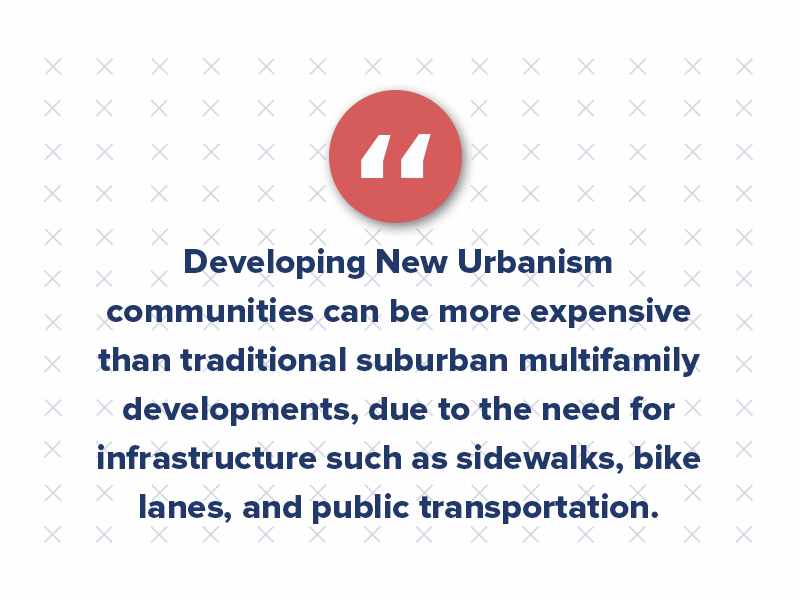
Another challenge is that New Urbanism multifamily developments may not appeal to everyone. Some people prefer the traditional suburban living model and may not want to live in a more densely populated area.
In addition, there are concerns about the potential for increased traffic and parking issues in New Urbanism multifamily developments. While the trend encourages public transportation and walking, some residents may still need to drive, and there may not be enough parking spaces to accommodate all residents.
Will the Trend Last?
Despite these challenges, the trend toward New Urbanism in multifamily living will continue. The demand for walkable, sustainable, and livable communities is growing, and developers increasingly recognize the benefits of New Urbanism.
In addition, the trend toward New Urbanism aligns with the broader trend toward sustainability and environmentally conscious living. As more people become aware of the environmental impact of traditional suburban living, they seek alternative models that are more sustainable and efficient.
What will this living look like? Apartments that blend with the environment; smaller and more thoughtful multifamily projects; carless cities and larger sidewalks; community gardens integrated into multifamily properties; or even smart cities. New Urbanists are working towards building cities that revolve around maximizing space, community, sustainability, and efficiency.
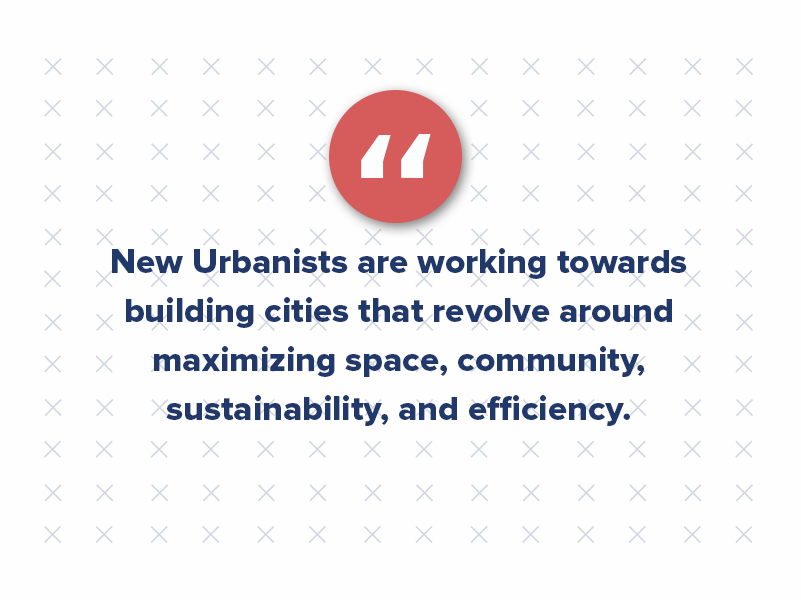
Buildings will no longer be a monument to themselves but instead, to the city streets.
Shaping the Future of Apartment Living
Although the popularity of New Urbanism is widely accepted, “an enormous invisible structure” hinders its full overhaul. To the government, this reinvention of city living is breaking code after code.
Local zoning codes restrict modernist design, form, and projects, ultimately restricting wider streets and increased walkability. However, there’s hope in progress; as this movement gains momentum, its impact will reach public officials and make a difference in urban life.
While there are challenges, the benefits of creating walkable, mixed-use communities are too significant to ignore. The trend toward New Urbanism in multifamily living is expected to continue, and it is poised to play a major role in shaping the future of apartment living.
Winning Tactics to Attract More Gen Z Renters to Your Property
The oldest members of Gen Z are turning 25 this year. They were only seven years old when Facebook launched; they had never known a time before the internet.
And guess what else? They will be the largest generation of apartment renters the industry has ever seen.
We just adapted to millennial renters, and now here comes Generation Z in full force. Before long, it will be time to adapt again to Generation Alpha (AKA “mini millennials”), but let’s not get too far ahead of ourselves.

Meet your Gen Z renters
First, who are your Gen Z renters? They’re the buzzed-about generation, and rightfully so, with $360 billion in disposable income. And Gen Z’s spending power is continuously on the rise.
While millennials have historically garnered all the attention from multifamily apartment properties, Generation Z has overtaken the rental market. This age group is typically born between the mid-1990s and 2010.

When comparing them to previous generations, online connectivity emerges as the defining characteristic. As such, this young population should be an extremely important part of your apartment marketing strategy.
Gen Z by the numbers
Let’s consider a few stats from a recent rentcafe.com survey of 2,500 Gen Z renters:
- 39% of Gen Z renters searched Google for their next apartment, while 27% specifically went to apartment search websites.
- 52% of Gen Z said they prefer non-agent apartment tours (e.g., self-guided or virtual tour options).
- 30% of this generation check ratings and reviews first, as compared with 28% of millennials and 25% of Gen X.
- 62% of Gen Z said apartment technology is either “extremely important” or “very important.”
- The No. 1 most important amenity to Gen Z renters is high-speed internet, followed closely by garage and parking.
- 36% of Gen Z renters said Instagram is their #1 social media platform.
- Smart locks and smart thermostats are twice as important to Gen Z as to millennials or Gen X.

What do Gen Z renters want?
Gen Z renters seek efficiency in leasing, new communication channels, and enhanced amenities. As these young adults continue to enter the rental market, it will become increasingly crucial for you to understand their expectations.
1. Smart technology
Now is the time to get ahead on your smart apartment technology and high-speed internet connectivity, as these amenities are more important to Gen Z renters than gyms, pools, and coffee bars.
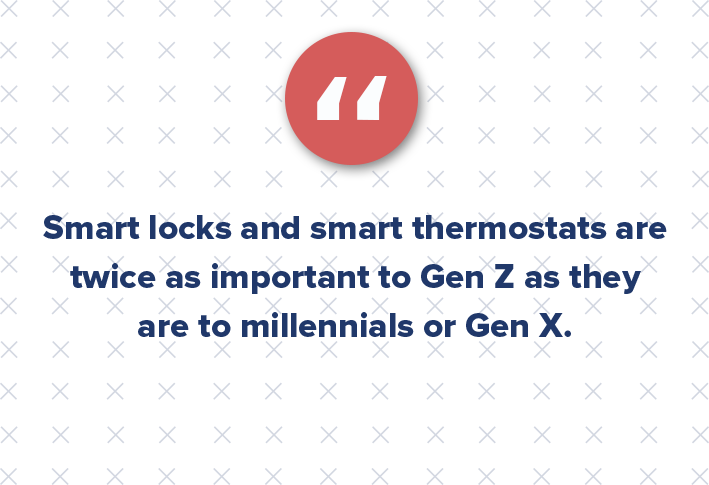
2. Mobile-first strategy
Gen Z’s technology use is fast-evolving in consumer marketing and the real estate industry. Smartphones are considered an extension of the body. Gen Z touches their smartphones 45 times daily for communication, entertainment, and informational purposes. About 29% of Gen Z are on their phones after midnight every night, and 31% said they feel uncomfortable without their phone for 30 minutes or less.
We don’t know what will if these stats don’t tell you to prioritize your mobile-first website!
3. More activity on social media
Social media is a natural forum for Gen Z to interact with friends and companies. In fact, their preferred method of communication is on social media rather than in person (even when it comes to their friends and family). This generation’s lifestyles and technology habits are causing us to rethink how we approach brand development, particularly in real estate.
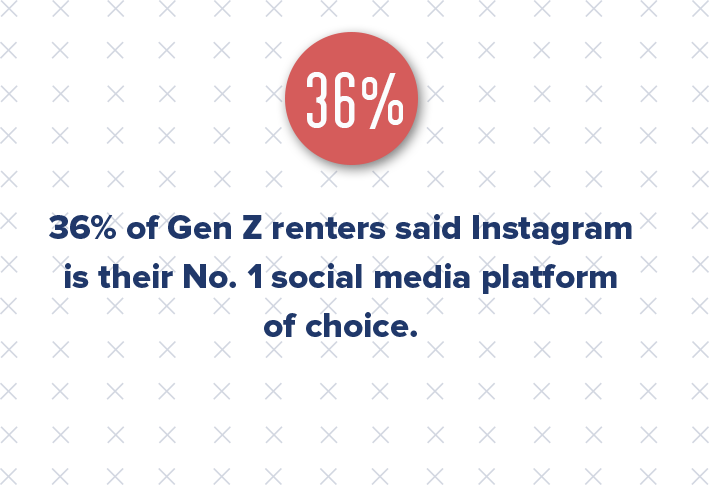
With technology at their fingertips, everything of interest to Generation Z is connected to social media. Your apartment marketing should focus extensively on the most popular social media platforms (i.e., Facebook, Instagram, Snapchat, and TikTok) and continually adapt as new social tools gain popularity.
While these young adults are known for their multitasking abilities when juggling various social platforms simultaneously, they are also known for “scrolling.” Your social media ads should, therefore, be attention-grabbing and specific. Hone in on your core message quickly or risk losing engagement. Focus your apartment marketing efforts on videos and other visually appealing content for the best results.
4. Rent longer. Rent by choice.
Aside from being the most coveted demographic, they’re also the most baffling for a traditional multifamily industry to understand. Compared to the generations before them, changing lifestyle preferences are beginning to propel several trends in multifamily development.
Gen Z is poised to rent longer than generations before, often by choice. If you compare it to the millennial generation, who waited longer to get married and start a family, Gen Z is expected to follow in a similar path. This trend will undoubtedly extend their rental lifetime well into their professional years.
5. More tour options and an adaptable leasing process
With over half of Gen Z renters preferring non-agent apartment tours, it will be up to your property to adapt and offer a mix of in-person, self-guided, and virtual tour options to increase conversions.
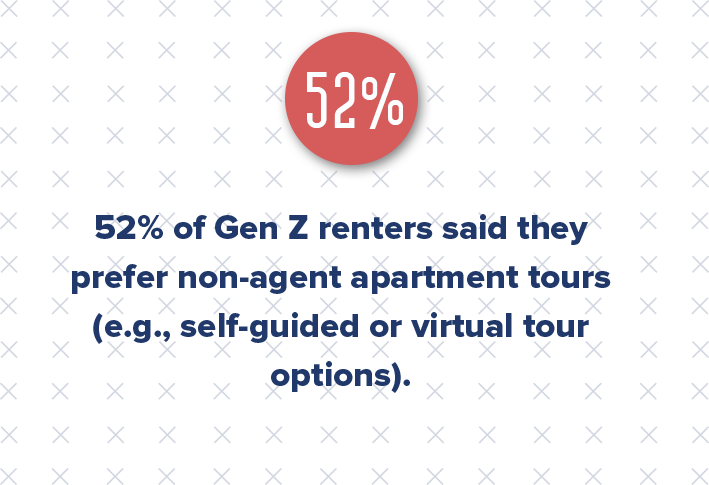
Regarding communication and the leasing process, a mobile-first strategy is also important. Gen Z is unlikely to hand-write a rent check or manually fill out a leasing application. They expect everything online, which includes leasing paperwork and payments.
Marketing to Gen Z renters
Gen Z lifestyle preferences drive key changes in multifamily development, but what does that mean for multifamily marketing? If you understand what’s important to them, you can understand how to attract them. This is how to maintain a customer-centric approach.
However, remember that being familiar with multifamily marketing trends is only a starting point. Your greatest demographic insights will come from the research you do yourself. The best way to research your target market is to develop resident personas. You can learn all about developing personas on our blog.
Again, when we know what’s important to prospective residents, we can understand how to attract and engage them.






